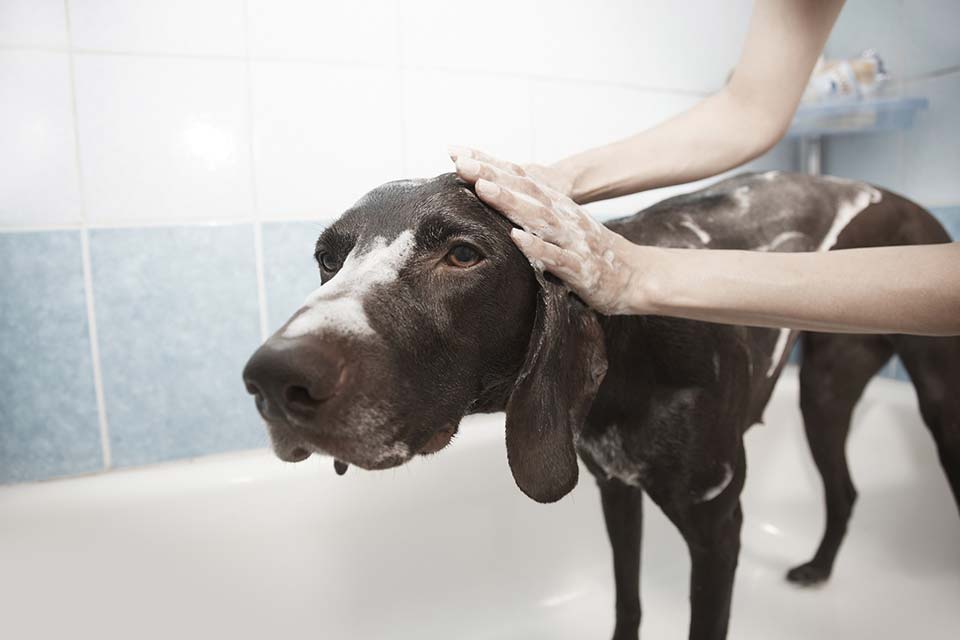Barks Blog
Bath Time
By Robyn Lowe of PPG corporate partner Canine Arthritis Management

I know for a fact this isn’t true of all dogs and especially for larger breeds it’s extremely difficult to bath them sometimes without the possibility of hurting their arthritic joints.
I thought I would do a quick whistle-stop blog on a few tips for bath time that might help!
- Start the process by having a calm environment, use pet remedy calming spray in the house/bathroom to help with anxiety levels.
- Ensure you place a bath mat, or towel, that won’t slip in the bottom of your bath or shower cubicle – this will not only help reduce the risk of injury to your dog, but also make them feel more secure and confident, as they can get more grip and feel more in control of their legs!
- If lifting a large dog into the bath GET SOME HELP! Not only will you damage your own back wresting your dog, but you will also risk them banging and resisting, causing trauma to their joints.
- If your dog hates the bath then we need to start positive training. We need to start bringing them into the bathroom for positive experiences such as a small treat or cuddle. Then working up to sitting in the bath or shower with a treat, then build up to some water. Remember some dogs won’t like it too deep; some won’t like the shower being on. Work out what upsets your dog and work around it, even if that means them being sponged off rather than have a full bath.. If your dog flips out in the bath or shower, it’s time to come up with a new system!
- Use a lick mat with something yummy on it to distract while bathing.
- Only bath if necessary. In general, a dog with a normal healthy skin and coat will not need very regular baths, but living in the UK at this time of year it gets very muddy and cold so it can’t always be avoided! That being said, a good waterproof coat may save you a lot of trouble!
- If needing to bath regularly to keep your pooch clean, avoid very scented shampoos which could irritate the skin. Speak to your vet or vet nurse if you’re not sure what type of shampoo would be suitable for your dogs skin and coat type.
- When lathering up your dog in doggy friendly shampoo, or drying off with a towel, remember to not be too rough on their painful joints. Use only gentle strokes!
- Keep them warm afterwards and don’t allow them stay wet and cold. If required wrap in a dry coat until thoroughly dried off and put on a jumper or other warm clothing (Like a snood if your dog is known to have a stiff neck) to keep them warm afterwards if necessary.
Provide them with a warm heat mat in their bed to warm up on afterwards – these are just a great treat for cold winter nights too!!
About the Author
Robyn Lowe of PPG corporate partner Canine Arthritis Management is a Registered Veterinary Nurse who qualified with a degree from Myerscough School of Veterinary Nursing in Preston, England, in 2016 and started her RCVS Diploma in Advanced Veterinary Nursing in 2018. She has worked on a volunteer basis with animals since she was four and her passion for the profession has only grown since then. She spent years of her life at the Horse and Pony Protection Association (HAPPA) and later at a local rescue and rehabilitation yard. Here she met a veterinary surgeon who inspired her, and went for her first work experience in 2008 at their busy mixed practice. She has also travelled to Thailand to volunteer her knowledge and skills working with elephants, horses, goats, pigs, water buffalo, cats and dogs. She loves osteoarthritis clinics and using multimodal approaches to managing the condition, stating that it can be extremely rewarding seeing both owners and patients travel this extremely difficult journey together to improve quality of life for their pet.

